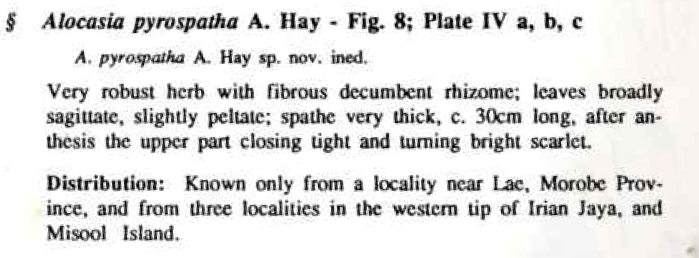ALOCASIA PYROSPATHA
ORIGINAL DESCRIPTION:
Ab Alocasia hollrungii Engler pedunculo fruciifero brevi erecto, spatha crasse coriacea, ovario scptato, sligmate minute lobato differt.
Typus: Papua New Guinea, Morobe Prov., Lae District, near Sankwep River Bridge, N ofLae, 10 January 1989,Hay & Karenga 4022 (LAE, holo;NSW).
SYNONYMS: N/A
DISTRIBUTION: Known only from the type locality in Papua New Guinea and four localities in West and North Irian Jaya
CLIMATE: Tropical humid climate
Humidity is moderate throughout the year, ranging from 60% to 70%
Temperature is varies between the seasons - within the range of 48°F/9°C to 88°F/31°C during the day. Minimum temperatures never dip below 45°F/7°C
Rainy and humid season (October to May) and a dry season between June and October. The average annual rainfall is 1,200 mm
ECOLOGY: On rainforest floor, under canopy gaps, and on forest edge, at c. 50-100 m altitude.
SPECIES DESCRIPTION:
Massive pachycaul herb; stem decumbent, to 13 cm diam., to 1.5 m long, clothed in the persistent fibres ofold leaf bases; leaves about 7 together; petioles to c. 1.4 m long, rounded on the abaxial side, flattenedadaxially, sheathing in the lower half; wings of sheath persistent, bronze to red-flecked, recurved at the margins; blade broadly sagittate, margin entire, sinus sometimes peltate with the petiole inserted c. 1.3 cm from the lamina margin; posterior costae divergent at 60-90 degrees, lamina-bearing to the sinus; posterior lobe to c. 45 cm long, 32 cm wide at widest point, rather rotund, blunt tipped; anterior lobe to c. 75 cm long, c. 60 cm wide at base, with 10 primary lateral veins per side, diverging at c. 75 degrees, running more orless straight to the margin; primary venation strongly raised adaxially, weakly raised abaxially; secondary venation weakly raised adaxially, flush abaxially; interprimary collective veins absent
INFLORESCENCE:
Inflorescences (3 or) 2 together, in five such pairs amongst the foliage leaves, each pair subtended by a large cataphyll similar in texture to the wings of the leaf sheath, the second inflorescence subtended by a diminutive bicarinate prophyll; peduncles c. 9 cm long, hidden within the cataphyll and leaf base; spathe 30 cm long, not or hardly constricted, in the lower third tapering from 3 to 1.8 cm diam., then the limb tapering more gradually to the pointed tip, opening slightly throughout its length at anthesis, ivory to pink, after anthesis closing tightly, the limb persistent, turning bright scarlet, the basal part enclosing the fruits remaining ivory, the whole thick, hard, and fleshy, held erect; spadix on a very short conical stipe; female zone 2.5 cm long, c. 1 cm diam., with c. 100 ivory coloured pistils; stigmas sessile, papillate, button-like, with 4 or 5 indistinct more or less conical lobes; ovary three- or four-locular; ovules hemianatropous; interstice of sterile organs 2 cm long, only very faintly tapering; male zone more or less cylindrical, c. 9 cm long, 1 cm diam.; synandria rhomboidal, c. 3 mm across; anthers opening by lateral slits not reaching the top of the synandrium; appendix very irregularly sulcate, c. 7 cm long, tapering to a point, ivory throughout; fruit c. 1 cm diam., orange red, several-seeded; seeds pale brown, c. 2.5 mm diam.
VARIEGATED FORMS: N/A
ETYMOLOGY: The specific epithet ‘pyrospatha’ comes from the latin pyro + spatha, referring to the bright scarlet color of this species’ spathe
NOTES:
The function of the intense coloration of the spathe after anthesis is unclear, as it appears long before the fruits are ripe. In the only known Papua New Guinea population, additional very distinctive characters are the peltate leaf and the fibrous rhizome. In the vegetative state the plants bear, from a distance, a strong resemblance to Alocasia macrorrhizos which may explain why the species has been overlooked (so near to Lae) until recently. We (Hay) have not seen plants of this species from Irian Jaya in the living state. However, the herbarium collections cited suggest that the Irianese plants may be smaller than those from the widely isolated Papua New Guinea population. Their leaves are not oronly barely peltate. There may be two geographical subspecies. Further collections from Irian Jaya might clarify the matter.
Other specimens seen: IRIAN JAYA. Rouffaer River, Motor Camp, Docters van Leeuwen 11077 (BO, L); Vogelkop, Manokwari,nr Ramsiki, Koslermans 2781 (BO); Misool Island, Sorong, nr Fakal,Pleyte 1039 (A, BO); Fakfak River, N of Fakfak, Vink BW12148 (A, BO, CANB, LAE). PAPUA NEW GUINEA. Near Sankweb River bridge, N of Lae, Hay 1404 (LAE)
CULTIVARS: N/A
HYBRIDS: N/A




